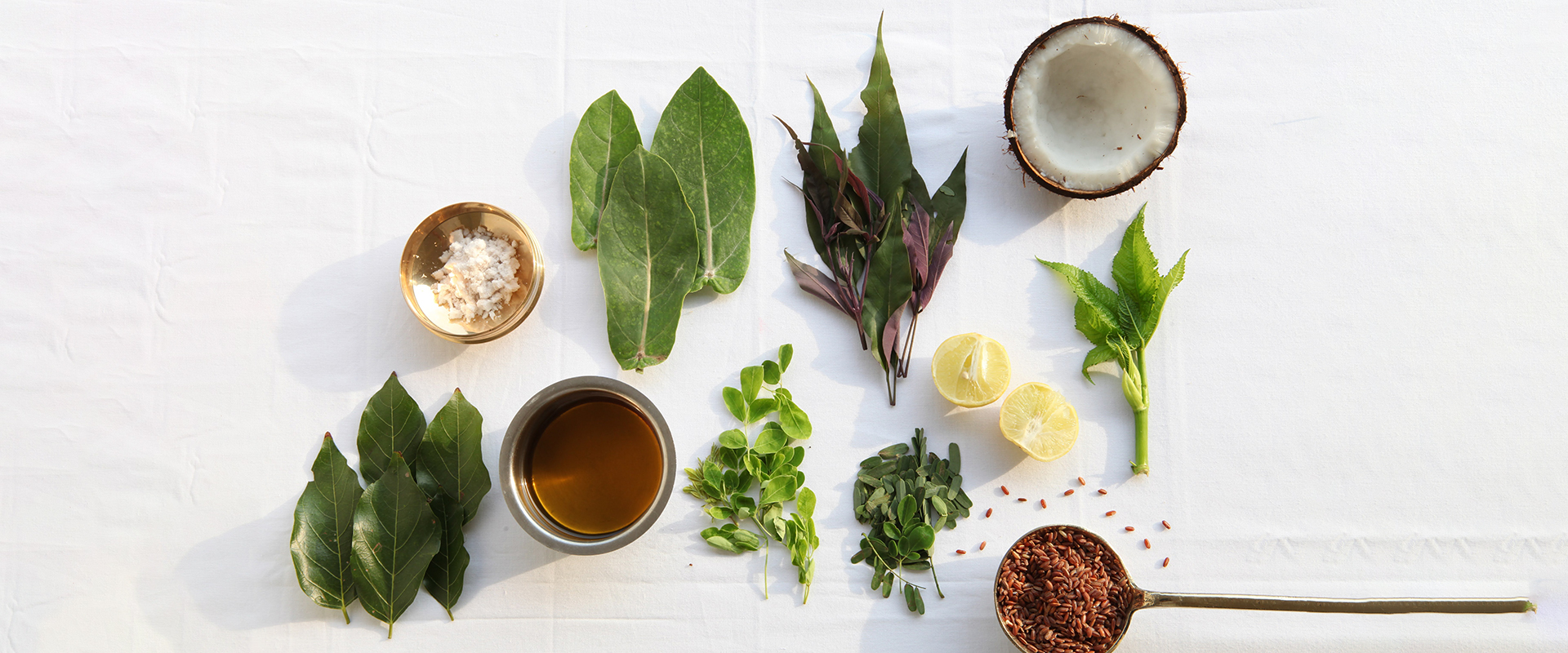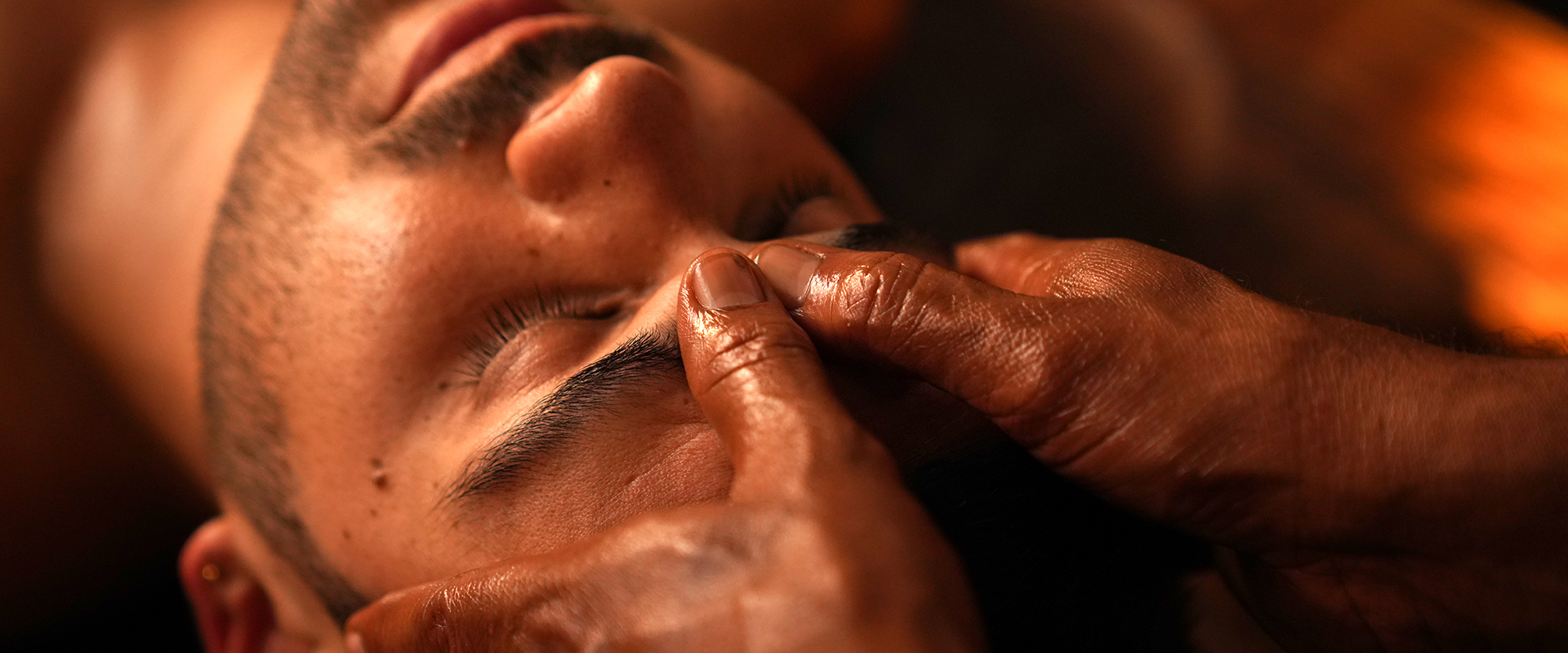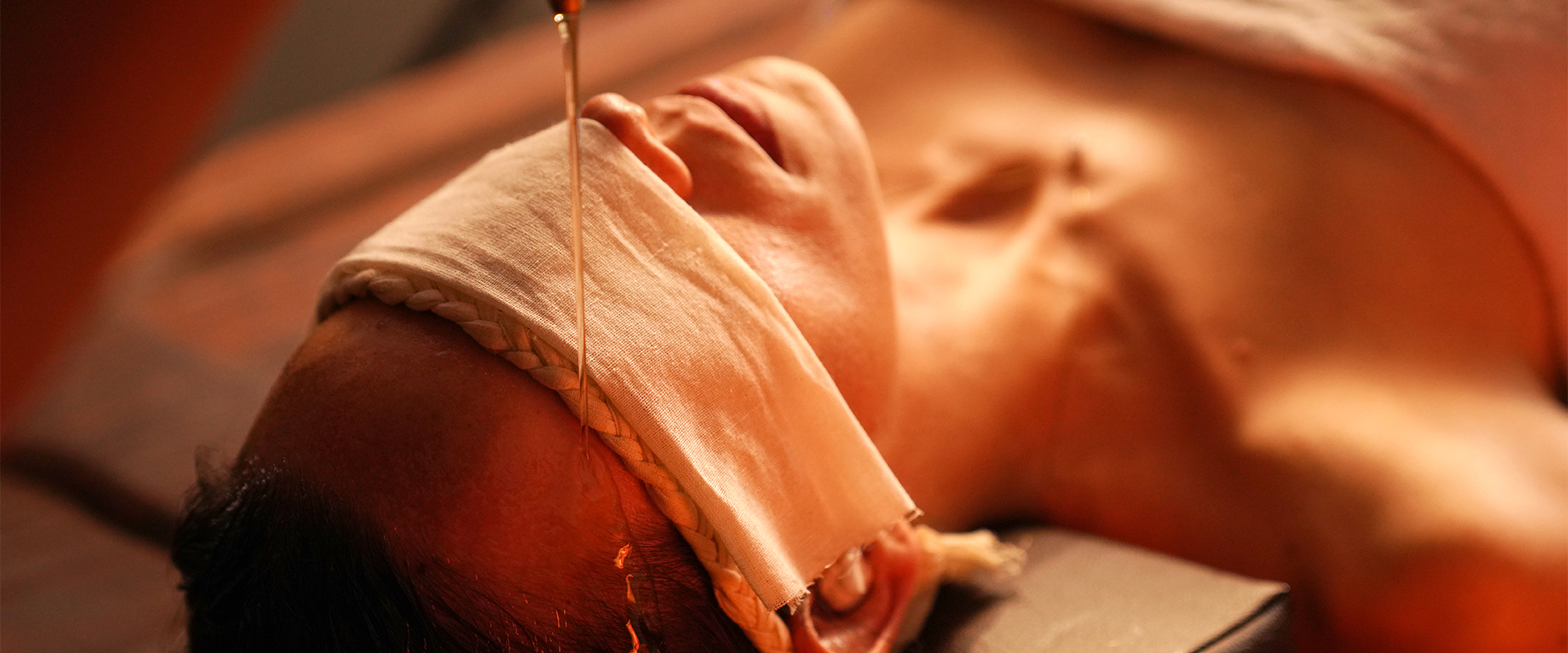TREATMENT
Basics of Ayurveda
आयुष: पालनं वेदमुपवेदमथर्वण:| (Astanga Sangraham.Su.1/8)
Ayurveda, an upaveda of Atharva Veda, encompasses all aspects of life protection and sustenance. It offers holistic health, addressing physical, mental, and spiritual well-being.
स्वस्थस्य स्वास्थ्यरक्षणमातुरस्य विकारप्रशमनं च|| (Charaka.Su.30/26)
Ayurveda has two main aims :
- Preserving the health of the healthy.
- Curing the disease in the unhealthy.
At SDJ Ayurvedalaya, we focus on curing imbalances and guiding individuals to practice healthy habits as per Ayurveda.
Parameters or Markers of Health as Explained by Acharya Kashyapa
अन्नाभिलाषो भुक्तस्य परिपाक: सुखेन च |
सृष्टविण्मूत्रवातत्वं शरीरस्य तु लाघवं ||
सुप्रसन्नेन्द्रियत्वं च सुखस्वप्नप्रबोधनम् |बलवर्णायुषो लाभ: सौमनस्यं समाग्निता ||
विद्यादारोग्य लिङ्गानि विपरीते विपर्ययम् ||(Kashyapa samhita. Khi.St 5/6-8)
Health is marked by
- Desire for food intake
- Proper digestion
- Easy evacuation of waste
- Lightness in the body
- Pleasantness in sense organs
- Proper sleep and awakening
- Strength, vitality, and a pleasant mind
- Normal agni (digestive fire)
Types of Treatments in Ayurveda
शोधनं शमनं चेति समासादौषधं द्विधा । (A.H.SU. 1/25, 26)
Shamanam: Palliative approach to suppress and balance doshas without expelling them.
Shodhanam: Remedial approach using purificatory procedures called Panchakarma.
यदीरयेत् बहिर्दोषान् पञ्चधा शोधनं च तत् |
निरुहो वमनं कायशिरोरेकोऽस्रविस्रुति: || (अ.हृ.सू.१४/५)
At SDJ Ayurvedalaya, we specialize in Shodhana Chikitsa or purificatory treatments for ailments.
The five actions or procedures that expel the vitiated doshas out of the body is called Shodhanam and the 5 procedures/ actions are
- Niruha : Decoction enema.
- Vamana : Emesis , Vomiting therapy.
- Kayareka orVirechanam : Purgation therapy.
- Shiroreka or Shirovirechanam or Nasya : Purgation for the head, Nasal instillation of medicines.
- Asra-Visruti or Rakta Mokshana : Blood letting.
वायु: पित्तं कफश्चेति त्रयो दोषा: समासत:॥
विकृताविकृता देहं घ्नन्ति ते वर्तयन्ति च। (A.H.Sutra Sthana 1/6)
Vayu (Vata), Pitta and Kapha are the three dosas in brief; they destroy and support the body when they are abnormal and normal respectively.
The concepts of Dosha and Prakrithi are highly profound and it would be an injustice to corner them as Humors, Body type & Constitution.
Mode of Operation
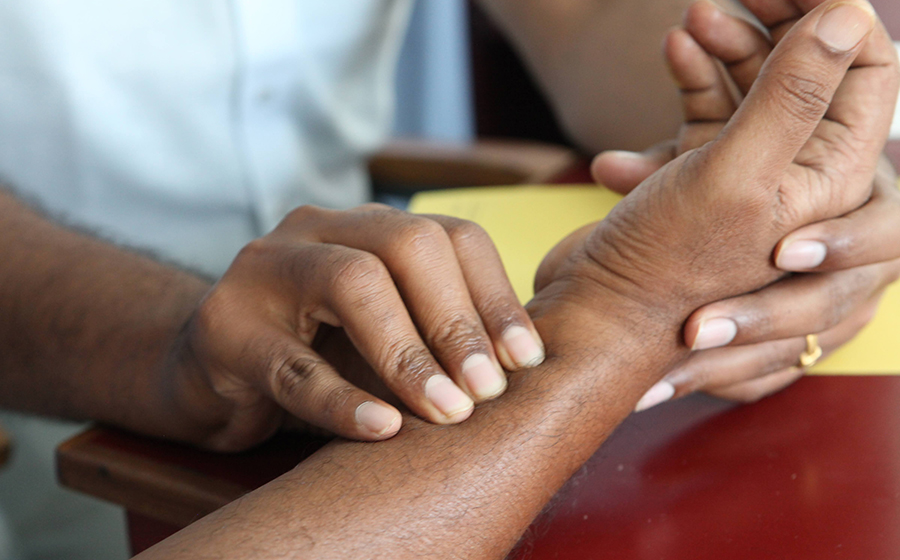
दर्शनस्पर्शनप्रश्नै: परीक्षेत च रोगिणम्।
रोगं निदानप्राग्रूपलक्षणोपशयाप्तिभि: ॥ (A.H.Sutra Sthana 1/22)
The process starts with the three kinds of Diagnostic procedures as explained in Ayurveda shastra which are
- Darshana – Observing
- Sparshana physical examination
- Prasna – Interrogating
Then a detailed evaluation of the disease is done based on Nidana – Causative Factors, Pragrupa - Prodromal symptoms, Lakshana – Signs and Symptoms, Upasaya- Factors causing alleviation of symptoms and Samprapthi – Disease pathogenesis.
The modern diagnostic tests reports and modern diagnosis are used as an additional tool for Ayurveda Diagnosis and accordingly arrive at a course of treatment.
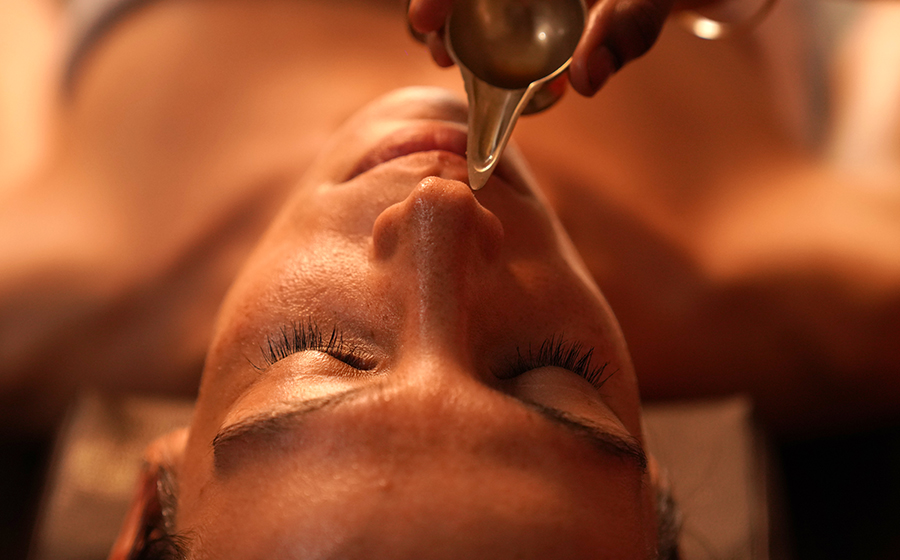
Panchakarma, which literally means "five actions," includes Vamana (induced vomiting), Virechana (purgation), Niruha Vasthi (decoction enema), Nasya (nasal medication), and Rakthamokshana (bloodletting).
Stages of Panchakarma Treatment
Poorvakarma (Preparatory Stage):
This stage prepares the body for the elimination of toxins through two main methods:
Snehanam Internal oleation with medicated ghee and external oleation with Abyangam (oil massage).
Swedanam: Therapeutic sweating to facilitate the movement of toxins to the gastrointestinal tract. Includes therapies like Tapa (dry heat), Drava (medicated liquid treatments), and Ushma (moist heat applications).
Pradhanakarma or Panchakarma ( Main stage ) The primary treatment phase where one or two of the five actions are performed. This phase can last for just one day, but Poorvakarma is usually the longest phase.
Paschatkarma (Post Care Stage) The recovery phase, focusing on diet and lifestyle. Treatments like Nyavarakizhi, Nyavaratheppu, Thalapothichil, Sirovasthi, and Abyangam are performed for rejuvenation.
Supporting treatments
Additional treatments include
-
Eye Treatments: Sekam (herbal water), Aschyothanam (eye drops), Bidalakam (eye paste), Anjanam (eyelid medicine), Tharpanam (medicated ghee/oil pool)
-
Head Treatments: Sirodhara (oil pouring on forehead), Shiro Pichu (cotton soaked in oil), Sirovasthy (oil pool on head).
-
Ear Treatments: Karna Poornam (oil in ear), Karnadhoopanam (ear fumigation).
-
Mouth Treatments:Gandoosham (holding medicated oil), Kabalam (oil gargling).
-
Face and Body Treatments: Mukahalepam (face treatment), Lepa (medicated paste), Pada Abhyangam (foot massage).
-
Vasthi Treatments Retaining oil over specific areas like Kadeevasthy (lower back), Januvasthy (knee), Greevas Vasthy (neck), and Uro Vasthy (chest).
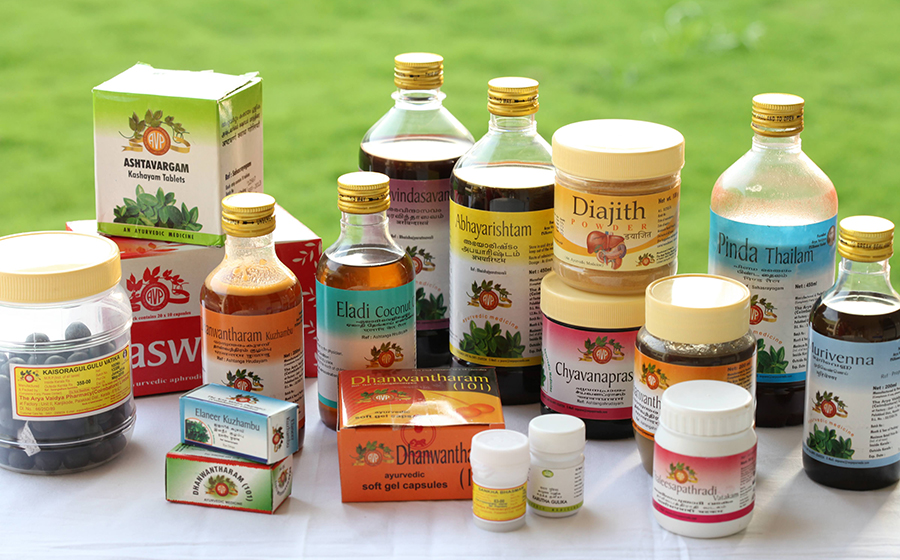
Commonly used internal medicines Include
Kashayam :Kashayam is an ayurvedic formulation prepared by taking aqueous extract by boiling raw herbs/drugs in water.
Kwatham/Kashayam tablet :Kashayam tablet is a relatively new concept in Ayurveda to make Kashayam into tablets with improved shelf life and convenience to carry and consume.
Arishtam and Asavam :Arishtam and Asavam is a concept based on controlled natural Alcoholic fermentation of herbs in a sugar medium.
Choornam :Choornam is a fine dry powder of herb or combination of different herbs mentioned in the classical formulation.
Gritham :Gritham is a Medicated ghee prepared by boiling the ghee, medicinal herbs in varous forms, liquids like water kashayam, Juice, milk etc.
Gulika / Vati / Guggulu :Powder of raw drugs are triturated together with certain Kashayam or Juice or even honey and prepared in the form of pills or tablets.
Lehyam and Rasayana :It is a semi-solid formulation prepared with herbs, juices and decoction, adding jaggery or sugar syrup & later, spices, honey etc are added as per the formulation.
The primary substance used for External treatments are medicated oils which are commonly called as Thailam.
Tailam is prepared by adding Kalka (herbal paste), kwatha (herbal decoction), and drava dravyas(liquids) to oil in specific proportions & subjecting them to a specified heating pattern which could go upto 5 days. By this process, one can ensure the transformation of the active therapeutic properties of the ingredients to the oils.

Food plays an important role in the treatment process and hence our carefully curated cuisine strictly adhering the principles of Ayurveda adds a great value to the treatment.
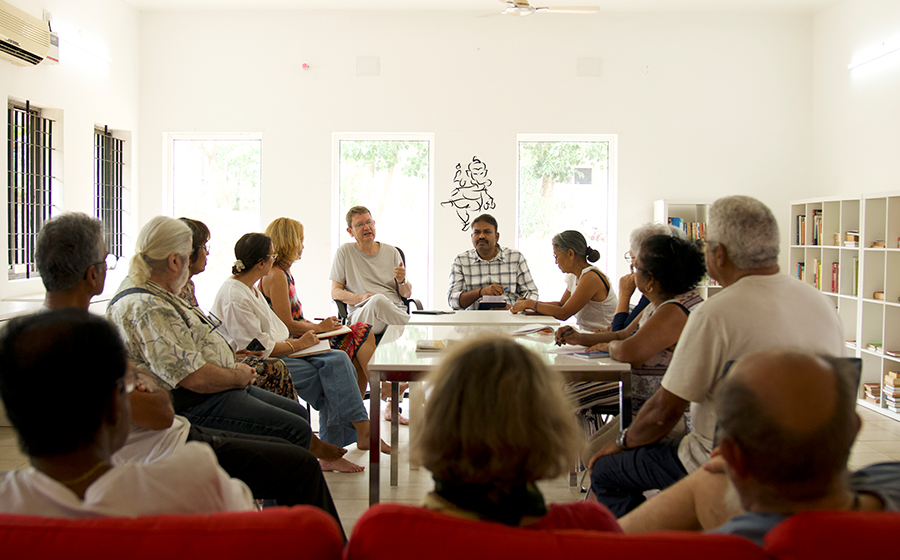
Your lifestyle and activities as mentioned in the wellbeing practices shapes your treatment and we will also host some activities like Bhajans, Ayurveda discussions, Guided Meditation, Celebrations, Prayers etc. that are congruent with the healing process
We learn that people take one or two days to settle & get used to this slow and natural rhythm. We suggest adequate rest on the initial days. Don’t fear missing out because this slow rhythm and surrendering to the experience is essential and rewarding. If one is restless and not being able to be in the do-nothing mode, it would be essential to let loose and try to just be and let things settle.
It’s normal to feel low during the process as the treatments are draining unlike the popular belief that it energizes day by day. There can be both physical and emotional drain, during the process and it’s necessary to just let it happen and witness it instead of getting entangled with it & hampering the process.
Mid way of the treatment process, there can be some flare-ups, both physically and emotionally which start to settle down after the subsequent main purification phase however the purification treatments are also physically draining. The Post-panchakarma stage of treatments would help one recover from it but the recovery continues even after going from here and hence we strongly suggest rest during the initial days after leaving SDJ.
At the end of one’s stay, there would be some sense of equilibrium and well- being but this is just the beginning the expected benefit starts here. Generally, it is seen that most patients respond positively 3 months after the completion of treatments
The extent of cure and time taken to experience the betterment depends upon the nature of a person, the nature of the problem, the chronicity of the problem, associated ailments, thoroughness in following the physician’s advice, Mind-set of the person, Faith of the person and even the astrological time cycle which is influencing the person. A peaceful and positive mind-set is required to get the maximum benefit from the treatments
Ayurveda treatments are not immediate alternatives for the allopathic medications & one cannot expect to quit one’s allopathic medicines by the end of or during the treatments. One might have to continue the regular allopathic medicines until advised otherwise.
We cannot predict the outcome of the treatments as it could be appreciated only after the treatments and we do not offer any guarantee on outcome During Ayurveda treatments, to enjoy the goodness of the treatments, we request you to be an observer of treatments and processes and not to analyse the treatments even if you are very knowledgeable about Ayurveda. Also, we do not encourage questions like “What is my Prakriti? What is my Dosha?” etc which are huge topics that need a lot of explanation.
Packages
This program follows the "Mode of Operation" as mentioned above and the treatment course will strictly adhere to Purvakarma, Panchakarma, and Paschat Karma with depth and authenticity.
As stated, not all treatments mentioned in the "Treatment Course" can be performed on every individual, but the three stages will be thoroughly covered. Vaidyas will select appropriate treatments based on the person's medical condition, Dosha vitiation, Dosha configuration, and assessment of Roga Bala (disease intensity) and Rogi Bala (patient strength).
This is best suited for individuals aged 18 to 70, those with multiple minor ailments, those seeking deep purification treatments, those recovering from lifestyle disorders and non-communicable diseases, and those wishing to overcome addictions and their complications.
This program offers a unique wellness experience for the body, mind, and consciousness through a simplified version of panchakarma but “The mode of operation” follows the same pattern .The treatment is smooth and gentle, yet aims for a holistic cleansing effect for overall wellbeing.
It is best suited for people aged 10 to 80, who do not have major illnesses, have few medical issues but limited time for treatments, wish to maintain better health, experience Ayurveda Panchakarma, improve strength, stamina, and immunity, and heal the body, calm the mind, and kindle the soul.
Depression, anxiety, mood swings, mental fatigue, and sleep disturbances have become so common that even children complain about them.
This program aims to relax both body and mind, rekindling consciousness positively, unlike antidepressant drugs that dull the mind. It also strives to improve overall health, emotional stability, and sleep patterns.
It is suited for those aged 14 to 80.
The "Mode of Operation" remains the same, but the treatment course will vary, with emphasis on treatments like ShiroDhara, Shirovasthi, Thalapothichil, Talam, and Nyavarakizhi based on the Vaidhya’s analysis. Additionally, a customized regimen, including guided meditation, Yoga Nidra, contemplation, pranayama, and Japa, will be specially advised.
Maintaining a particular weight is more fashionable nowadays than for health benefits. However, keeping it in an ideal range for health is more important than an ideal BMI. Our holistic weight management program prioritizes health, promoting gentle and natural weight loss over time. Weight loss should be a natural, irreversible effect of the process, making it a long-term plan, not focused on daily weight loss.
There will be no rigorous practices like starving or strenuous exercise for quick results.
This program is suited for those aged 16 to 70. Obese individuals with associated high blood pressure, diabetes, high cholesterol, etc., will see improvements in those aspects too.
The mode of operations and treatment courses are similar to previous programs but with extra focus on Rukshana treatments like Udwwarthana, Podikizhi,Kadikizhi etc. There will also be customized food and regimen practices to achieve our goal.
This Composite program follows the same pattern as a Panchakarma package, with a special focus on the individual's ailment, allowing for rich customization and holistic healing.
Commonly treated ailments include spondylitis, arthritis, slip disc, low back pain, sports-related injuries, respiratory diseases, diabetes, paralysis, migraine, menstrual problems, menopause issues, PCOD, neurological complaints, psoriasis and other skin issues, IBS, digestive disorders, stomach ulcer, constipation,infertility and more.
People aged 16 to 80 can avail of this treatment, but confirmation requires a Vaidya's discretion based on the medical details provided.
Other Information
-
Your blood pressure will be monitored regularly, and your weight will be measured once a week.
-
Diabetic patients should frequently check their blood sugar levels with their glucometers. If you don't have one, we can provide a check for INR 50 per test.
-
Treatments typically start on the day of arrival if you arrive before 1 PM. For arrivals after 1 PM, treatments usually begin the next day, although we will try to complete the medical consultation if time permits.
-
Treatments can start any day of the week, but ideally not on Saturdays for astrological reasons.
-
The type, time, room, and therapist allocation for treatments are decided by the Vaidya, considering various factors. Treatment slots are available from 9:00 AM to 5:15 PM, and your slot will be scheduled with prior notice.
-
Avoid strenuous physical activities during your stay, including intense yoga asanas. Gentle, relaxed asanas are acceptable. Sexual activity is strictly prohibited.
-
Pranayama and meditation are encouraged to enhance the treatment process.
-
Minimize energy drain by avoiding intense discussions, excessive gadget use, internet use, reading, writing, or thinking. Keep any necessary office work to a minimum.
-
Wear easy-to-remove garments to the treatment room. You will be provided with a disposable loin cloth for the treatment. Afterward, you will be given an asisted bath in the treatment room.Bath time should be a maximum of 15 minutes to maintain the schedule for the next person
-
Dry your hair completely after the treatment/bath, either with a towel in mild sun or using a hairdryer. We have hairdryers available on a use-and-return basis.
-
Avoid exposure to sun, wind, rain, and cold weather during treatments. For gentle walks around the campus, choose moderate times of the day. Night walks are discouraged due to cold and wildlife. Specific treatment restrictions will be explained by the Vaidyas as needed.
-
If you are in an air-conditioned room, avoid using it at least 2 hours before and after treatments. Use it sparingly and close to the outside temperature at other times.
-
Women should plan their arrival considering their menstrual cycle, as external treatments are not given during menstruation.
-
Allow time for recovery after discharge and rest well before resuming your normal routine.
External treatments are contraindicated for those with fever, cough, cold, or runny nose. Treatments will begin only after these symptoms are addressed.

